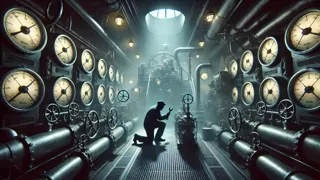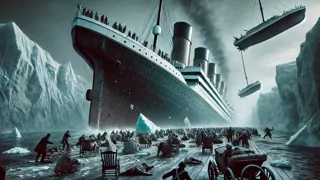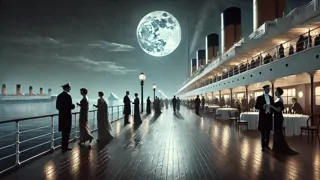Introduction
From the moment RMS Titanic’s hull slipped into the dark waters off Belfast, an uneasy hush descended on her polished decks. Beneath the grand sweep of her starboard promenade, passengers strolled in evening coats and silk gowns, champagne glasses catching the glow of gas lamps. Each smile concealed a story: an ambitious banker wrestling with loss, a young stenographer hunting opportunity in New York, a married couple chasing a fresh start—and hidden among them, a figure in rumpled overalls who moved through the boiler rooms with methodical purpose. His black boots echoed on iron catwalks, and in the steel arteries of the ship, tiny wrenches twisted bolts ever so slightly out of place. Up above, the wireless operator replayed iceberg warnings, unaware that an even deadlier threat lurked within the vessel’s beating heart. As moonlight shimmered across the Atlantic’s glassy surface, rippling faintly against the bow, the saboteur’s work took shape: steam pipelines weakened, valve seals eased, and on midnight watch, the engineers felt tremors they suspected were nothing more than an unexplained vibration. But when a stoker discovered loosened grates and a steward found dripping pipes in a first-class suite, alarm spread from the underbelly to the grand staircase. Night air carried distant laughter, lifeboats hung silently by davits, and the promise of dawn seemed all too distant. In that fragile twilight, a handful of strangers—bonded by courage and dread—would choose to fight or flee, knowing the grand finale loomed where steel met frozen water.
Echoes Below: The Saboteur’s Shadow
The labyrinth of steel pipes and coal-fired boilers under the Titanic’s decks resembled a hidden city, where shadows moved like ghosts and every hiss of steam carried a warning. Joseph Mallory, a stoker with a scar across his cheek, braved the furnace rooms each morning, his face smudged with soot and determination. When he spotted a loose valve taped crudely with tarred cloth, his heart thundered. He followed the line deeper, sweat dripping through his hair, until he came upon a man crouched over a row of pressure gauges. The figure froze, wrench in hand, but Joseph’s raised lantern revealed eyes glinting with cold purpose.

What followed was a frantic scramble down narrow catwalks, Joseph’s heavy boots clanging against metal. The saboteur darted into a service corridor, where crates of fine china rattled from above. At first-class level, the hush of piano notes and laughter collided with the echoing alarms Joseph sounded in panic. Passengers turned, glass in hand, to witness the steward’s warning: "Sabotage! Do not relax!" Throngs of elegant travelers scanned the deck, uncertain whether to retreat or rally, while officers rushed from cabins, revolvers drawn and whistles shrill. Below decks, crewmen abandoned coal shovels to hammer at wedged hatches, racing against a subtle but deadly clock.
Each sabotaged valve added a fraction more danger: a leak here, a pressure spike there, until the ship’s humming engines trembled with uncertainty. Even as Titanic carved through the ocean with majestic grace, Joseph and a handful of allies—an obstinate wireless operator named Ellen, a retired naval engineer called Harris, and a determined young reporter, Samuel Greene—pieced together the pattern. They worked feverishly beneath flickering lights, their breaths echoing off iron walls, knowing that any second could bring calamity far greater than an iceberg’s scar.
Ice Warnings and Rising Stakes
By afternoon, lookouts high in the crow’s nest scanned a horizon dotted with floating ice. Wireless crackled with messages from other ships: warnings of fields ahead, urgent calls to slow down. Captain Smith paced the bridge, gravity tugging at his brow, while deckhands heaved blocks carelessly against timber ships’ rails. Below, Joseph and Ellen relayed the sabotage map they’d drawn, tracing sabotage sites like landmarks on a cursed map.

Each new discovery heightened the urgency. The compound eyes of the ship’s wireless lattice intercepted a message from the Californian, but interference locked it until the next watch. Ellen seized the moment to warn of foul play; her voice quivered as she detailed twisted valve stems and deliberate markings carved into steel beams. Officers exchanged glances, the weight of command in their stiff shoulders. "Search every hold," they barked. But the saboteur had learned to vanish, slipping through maintenance hatches into the labyrinth where coal dust cloaked footprints.
Dinner service in first class resumed beneath crystal chandeliers, a tableau of elegance defiantly staged against impending doom. Passengers raised glasses to champagne’s golden sparkle, unaware that the Titanic’s heartbeat flickered with betrayal. Samuel Greene traipsed the promenades, notebook in hand, scribbling accounts he dared not publish—yet. The southern sky glowed pink over the port side, but the northern expanse remained a sliding canvas of shadow. In that twilight, each man and woman confronted a question: trust in the ship’s reputation or trust the instincts of those who knew her arteries were compromised? They chose action. Lifeboats were readied, watertight doors tested, saboteurs hunted. As icebergs shimmered like phantom spires on the horizon, the struggle between human ingenuity and human malice surged to a crescendo.
Collision Course: Courage Meets Catastrophe
Late morning brought the fateful moment. A blackout of the engine signals—an engineered glitch—masked the approaching field, and at the wheel, misread gauges steered Titanic toward a looming mountain of ice. Deckhands cried out as the lookout’s whistle finally pierced the murky air. "Iceberg—right ahead!" Captain Smith ordered a full starboard turn, but the ship’s great mass betrayed her. The bow scraped past jagged ice, steel plating groaning under the impact, sending a shudder through every deck.

Below, in the hold where sabotage had drained key compartments of watertight security, Joseph felt the ship lurch. Water began to seep through seams pre-weakened by that clandestine hand. Harris and Ellen slammed hatches shut, cranks grinding against compromised nuts—every twist a gamble. Steam hissed as they forced doors to align, even as icy water hissed across metal floors. Above, Samuel Greene raced for the grand staircase, slamming emergency bells and urging women and children toward lifeboats. Chairs overturned in panic, luggage tumbled from corridors, and the scent of salt and fear mingled in the air.
In the chaos, the saboteur emerged, wrench still in hand, eyes wild. Confronted by Joseph’s roar of fury, he revealed motives born of bitterness—a scorned worker whose family lost in an earlier accident. But justice would not wait for confession; lifeboats swung free, ropes jerking with the weight of souls desperate for safety. Sparks flew as gangways swung, and above them, the Titanic’s great funnels tilted against an unforgiving sky. In those final moments, courage was measured by the ones who ran toward hazard: the engineer staying to close the last bulkhead, the steward guiding blind passengers through rising water, the reporter carrying a child to safety. Beneath the shadow of betrayal and the groan of steel, humanity proved stronger than fear.
Conclusion
As dawn’s first light brushed the Atlantic horizon, the remnants of the great liner shuddered and settled. Lifeboats floated in ragged lines, faces streaked with salt and tears, hearts pounding from the night’s horrors. Hundreds had escaped, guided by indomitable courage and the efforts of those who refused to stand idle. Yet among the survivors, memories of forged bolts and covert valves lingered like ghostly reminders: the tragedy could have been far worse without those who chose to fight sabotage with honesty and grit. Joseph Mallory’s soot-smeared face, Ellen’s trembling hands on the wireless key, Harris’s weary arms reversing conflagrations, and Samuel Greene’s steady footsteps amid chaos—all became legends whispered in the cold breeze. The Titanic’s remains lay silent beneath the waves, a steel testament to human hubris and the fragility of great dreams. The saboteur’s plot was laid bare, not for vengeance, but as a warning: even the grandest marvel can fall to hidden malice. In rescuing hundreds against seemingly impossible odds, an unlikely fellowship proved that courage, compassion, and determination can illuminate the darkest hours. Their story would voyage across oceans and decades, reminding every generation that faith in one another is the greatest salvation.



















